The Python Toolbox for Neurophysiological Signal Processing.
Project description







The Python Toolbox for Neurophysiological Signal Processing
This package is the continuation of NeuroKit 1. It’s a user-friendly package providing easy access to advanced biosignal processing routines. Researchers and clinicians without extensive knowledge of programming or biomedical signal processing can analyze physiological data with only two lines of code.
Quick Example
import neurokit2 as nk
# Download example data
data = nk.data("bio_eventrelated_100hz")
# Preprocess the data (filter, find peaks, etc.)
processed_data, info = nk.bio_process(ecg=data["ECG"], rsp=data["RSP"], eda=data["EDA"], sampling_rate=100)
# Compute relevant features
results = nk.bio_analyze(processed_data, sampling_rate=100)And boom 💥 your analysis is done 😎
Installation
You can install NeuroKit2 from PyPI
pip install neurokit2or conda-forge
conda install -c conda-forge neurokit2If you’re not sure what to do, read our installation guide.
Contributing



NeuroKit2 is the most welcoming project with a large community of contributors with all levels of programming expertise. But the package is still far from being perfect! Thus, if you have some ideas for improvement, new features, or just want to learn Python and do something useful at the same time, do not hesitate and check out the following guides:
Documentation






Click on the links above and check out our tutorials:
General
Examples
You can try out these examples directly in your browser.
Don’t know which tutorial is suited for your case? Follow this flowchart:
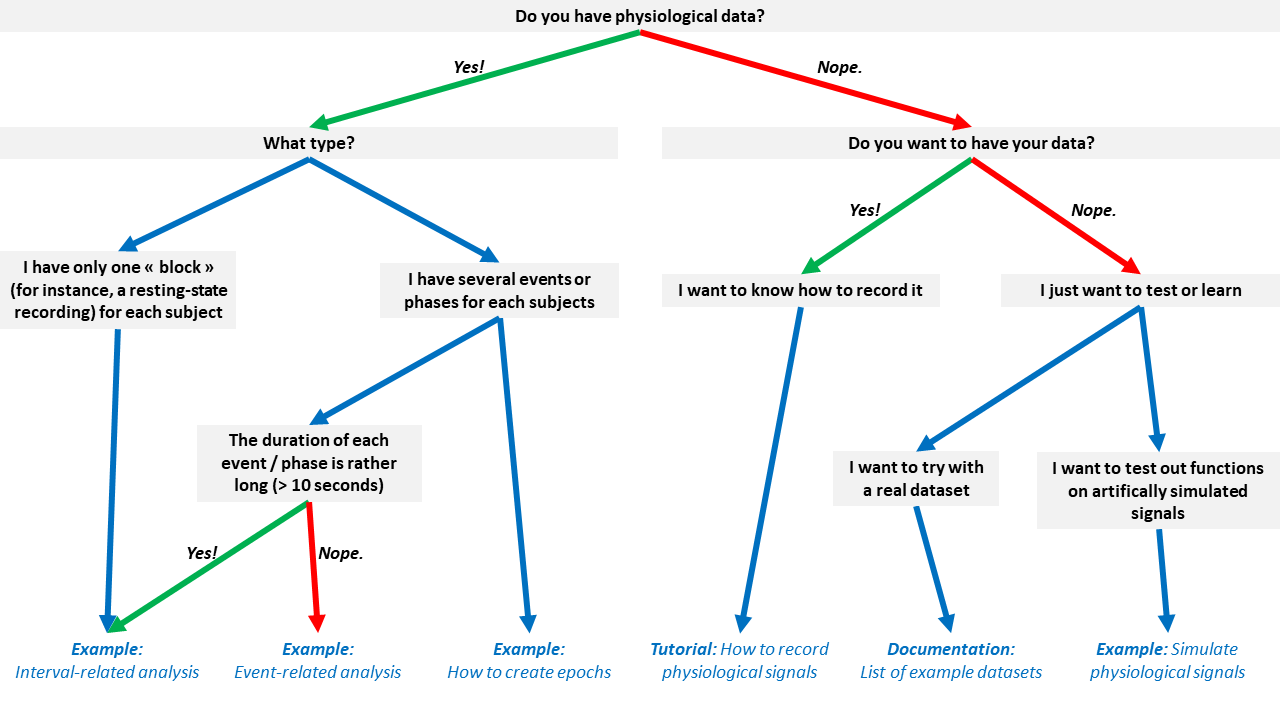
Citation


The NeuroKit2 paper can be found here 🎉 Additionally, you can get the reference directly from Python by running:
nk.cite()You can cite NeuroKit2 as follows:
- Makowski, D., Pham, T., Lau, Z. J., Brammer, J. C., Lespinasse, F., Pham, H.,
Schölzel, C., & Chen, S. A. (2021). NeuroKit2: A Python toolbox for neurophysiological signal processing.
Behavior Research Methods. https://doi.org/10.3758/s13428-020-01516-y
Full bibtex reference:
@article{Makowski2021neurokit,
author={Makowski, Dominique and Pham, Tam and Lau, Zen J. and Brammer, Jan C. and Lespinasse, Fran{\c{c}}ois and Pham, Hung and Sch{\"o}lzel, Christopher and Chen, S. H. Annabel},
title={NeuroKit2: A Python toolbox for neurophysiological signal processing},
journal={Behavior Research Methods},
year={2021},
month={Feb},
day={02},
issn={1554-3528},
doi={10.3758/s13428-020-01516-y},
url={https://doi.org/10.3758/s13428-020-01516-y}
}Let us know if you used NeuroKit2 in a publication! Open a new discussion (select the NK in publications category) and link the paper. The community would be happy to know about how you used it and learn about your research. We could also feature it once we have a section on the website for papers that used the software.
Physiological Data Preprocessing
Simulate physiological signals
import numpy as np
import pandas as pd
import neurokit2 as nk
# Generate synthetic signals
ecg = nk.ecg_simulate(duration=10, heart_rate=70)
ppg = nk.ppg_simulate(duration=10, heart_rate=70)
rsp = nk.rsp_simulate(duration=10, respiratory_rate=15)
eda = nk.eda_simulate(duration=10, scr_number=3)
emg = nk.emg_simulate(duration=10, burst_number=2)
# Visualise biosignals
data = pd.DataFrame({"ECG": ecg,
"PPG": ppg,
"RSP": rsp,
"EDA": eda,
"EMG": emg})
nk.signal_plot(data, subplots=True)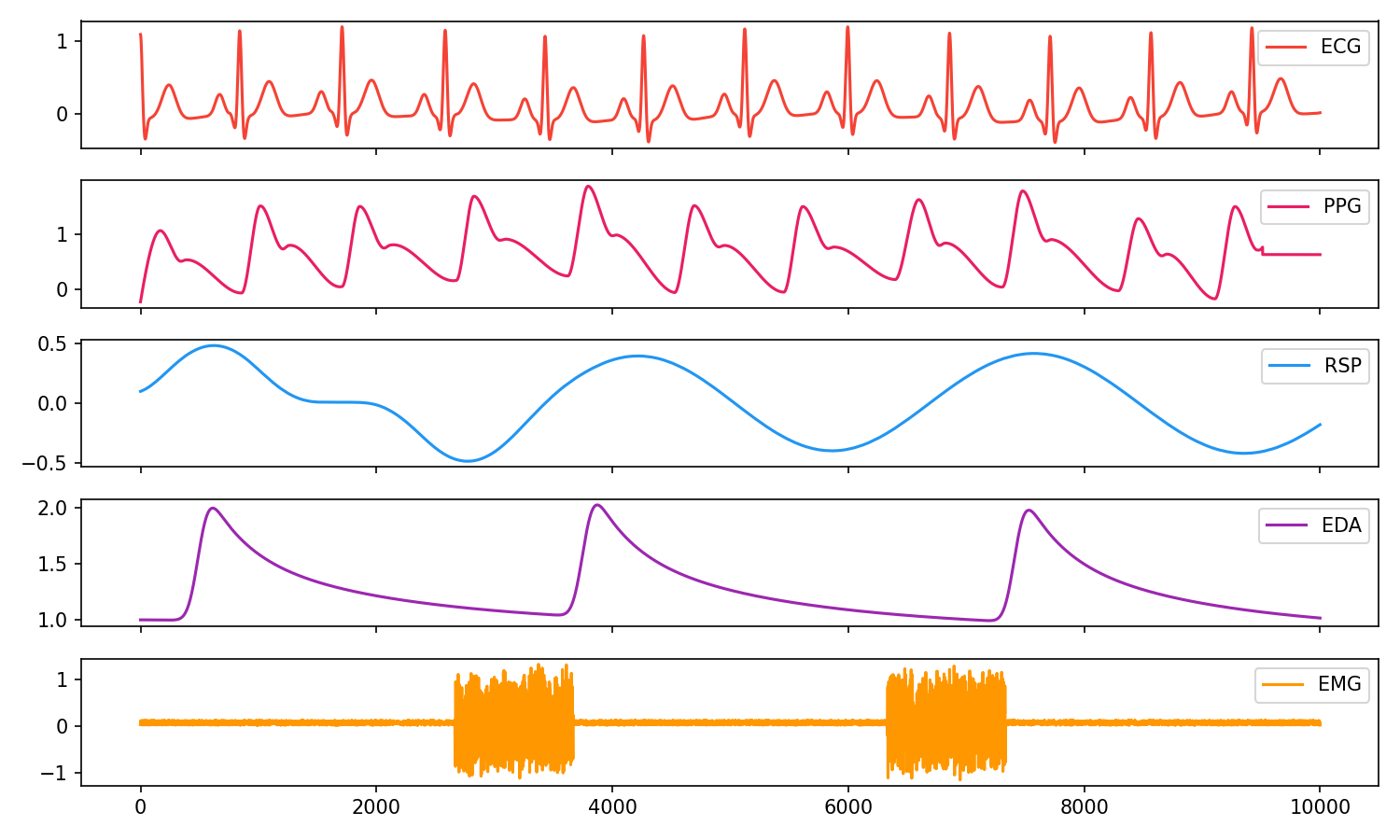
Electrodermal Activity (EDA/GSR)
# Generate 10 seconds of EDA signal (recorded at 250 samples / second) with 2 SCR peaks
eda = nk.eda_simulate(duration=10, sampling_rate=250, scr_number=2, drift=0.01)
# Process it
signals, info = nk.eda_process(eda, sampling_rate=250)
# Visualise the processing
nk.eda_plot(signals, sampling_rate=250)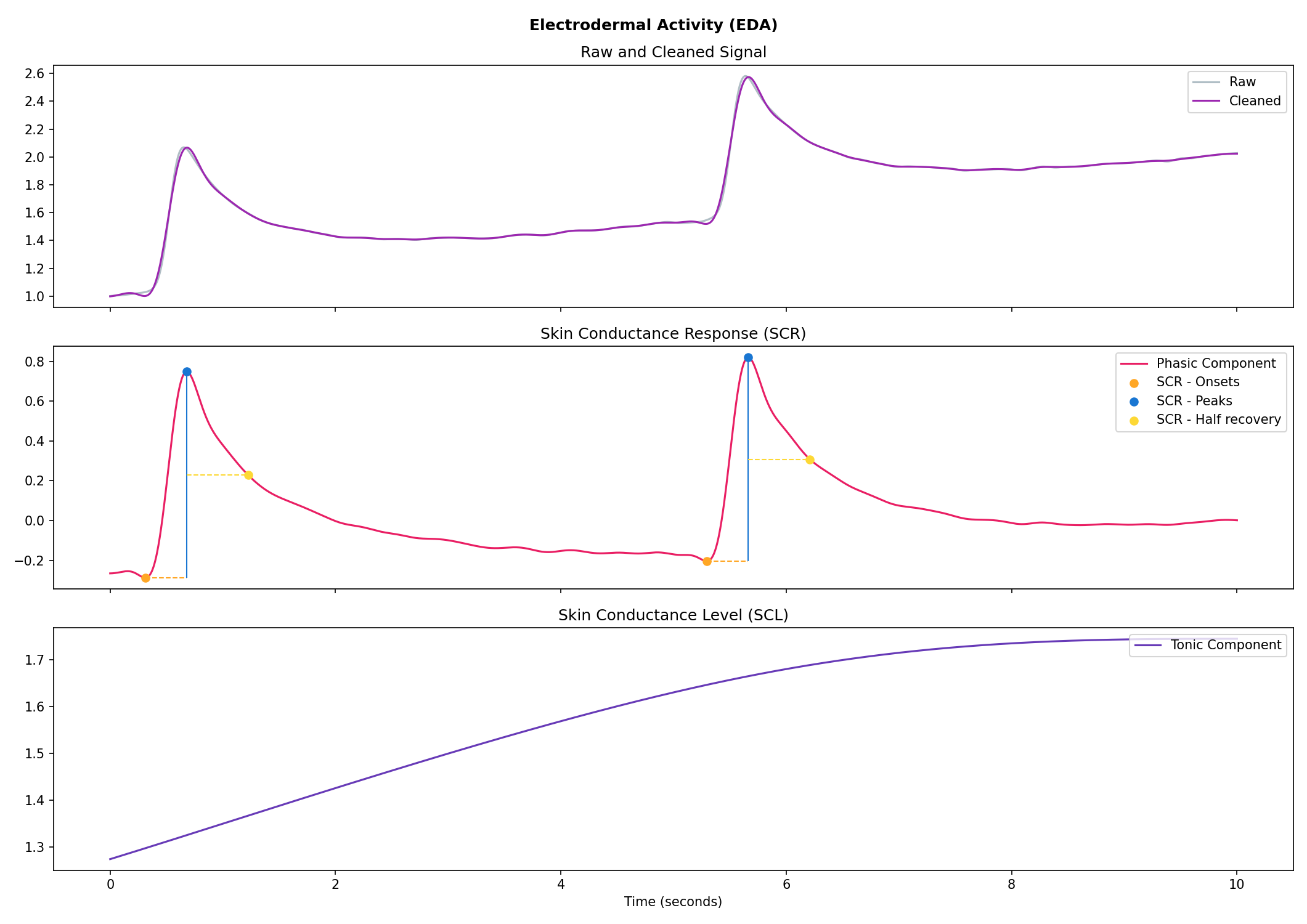
Cardiac activity (ECG)
# Generate 15 seconds of ECG signal (recorded at 250 samples / second)
ecg = nk.ecg_simulate(duration=15, sampling_rate=250, heart_rate=70)
# Process it
signals, info = nk.ecg_process(ecg, sampling_rate=250)
# Visualise the processing
nk.ecg_plot(signals, sampling_rate=250)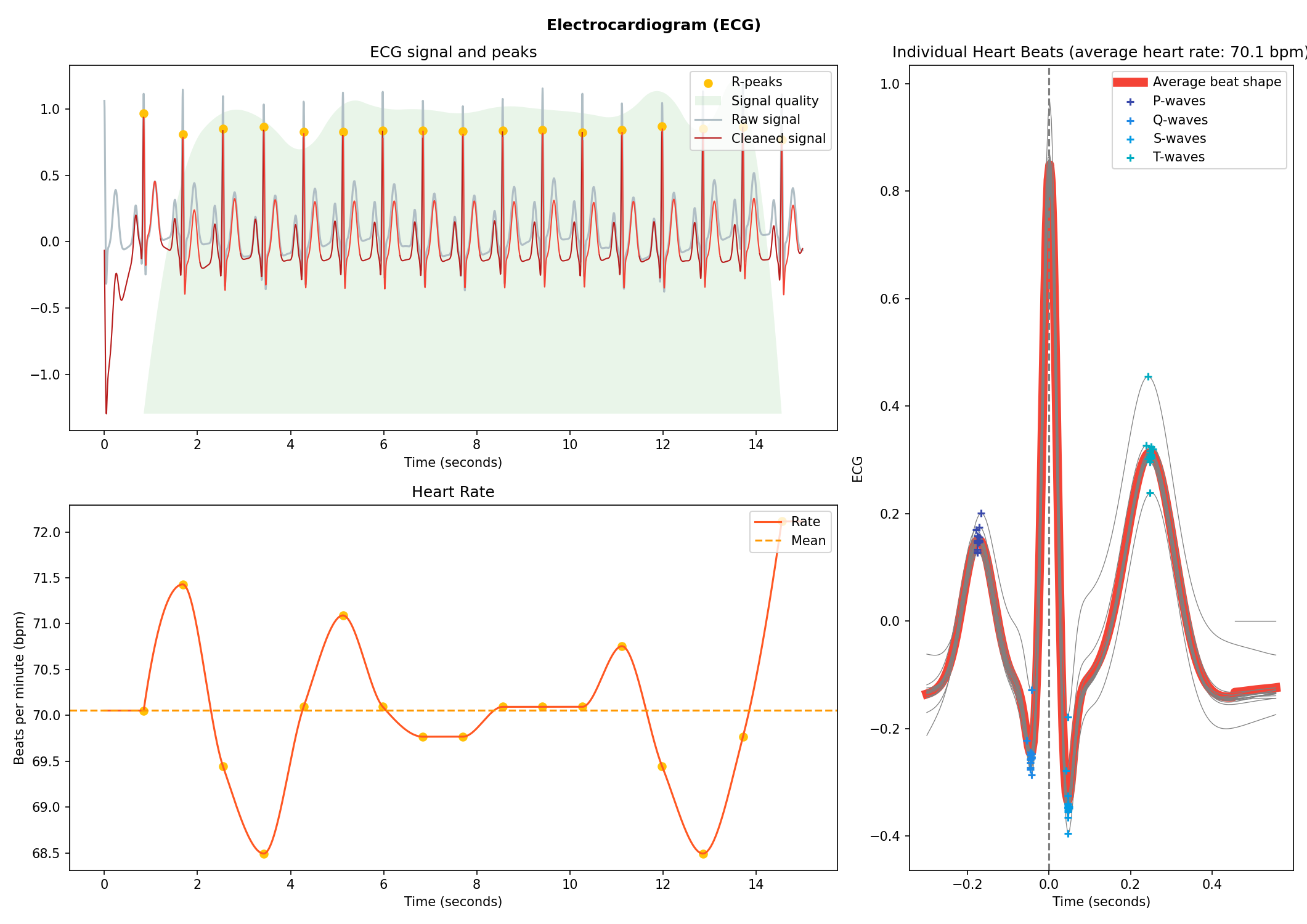
Respiration (RSP)
# Generate one minute of respiratory (RSP) signal (recorded at 250 samples / second)
rsp = nk.rsp_simulate(duration=60, sampling_rate=250, respiratory_rate=15)
# Process it
signals, info = nk.rsp_process(rsp, sampling_rate=250)
# Visualise the processing
nk.rsp_plot(signals, sampling_rate=250)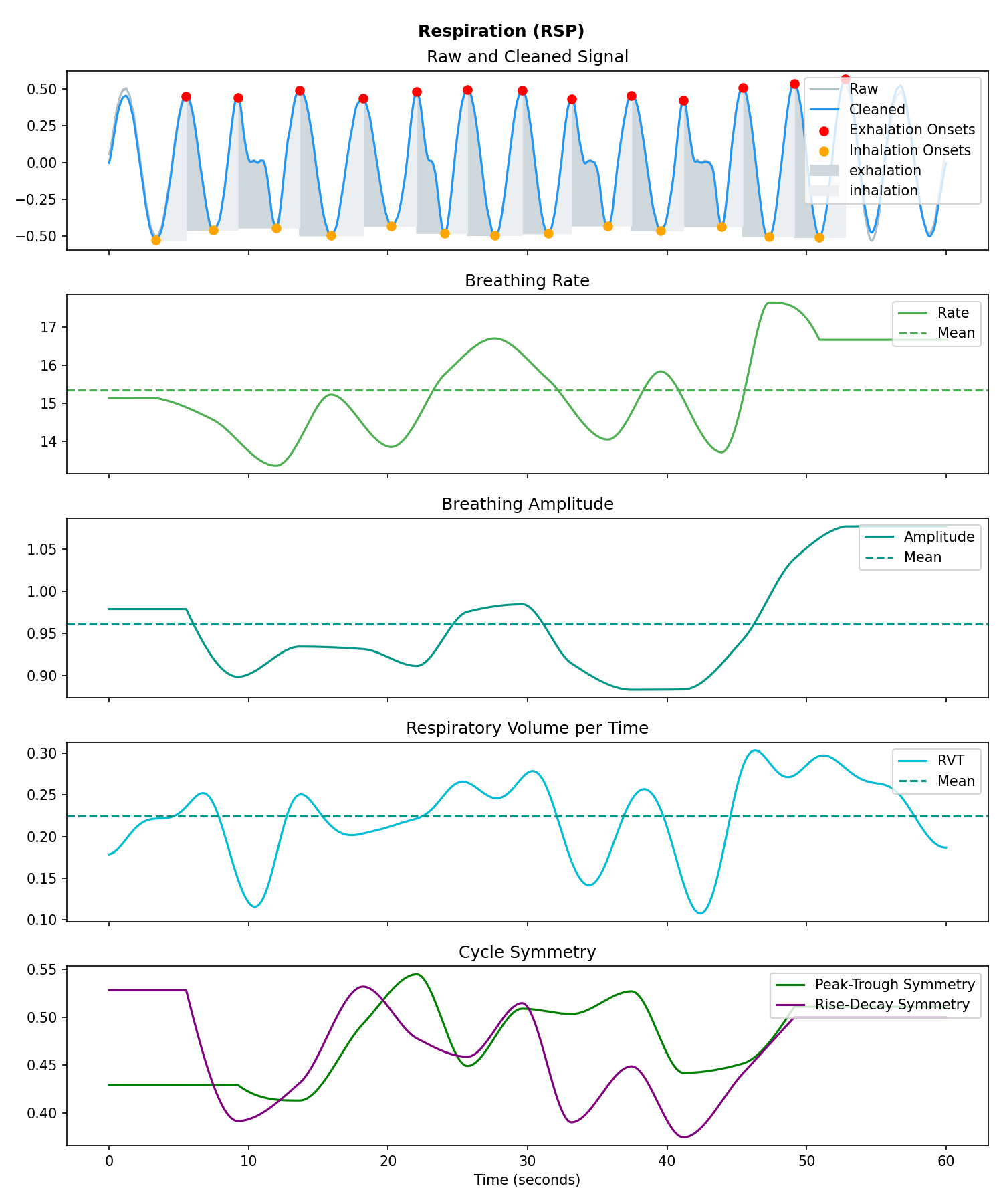
Electromyography (EMG)
# Generate 10 seconds of EMG signal (recorded at 250 samples / second)
emg = nk.emg_simulate(duration=10, sampling_rate=250, burst_number=3)
# Process it
signal, info = nk.emg_process(emg, sampling_rate=250)
# Visualise the processing
nk.emg_plot(signals, sampling_rate=250)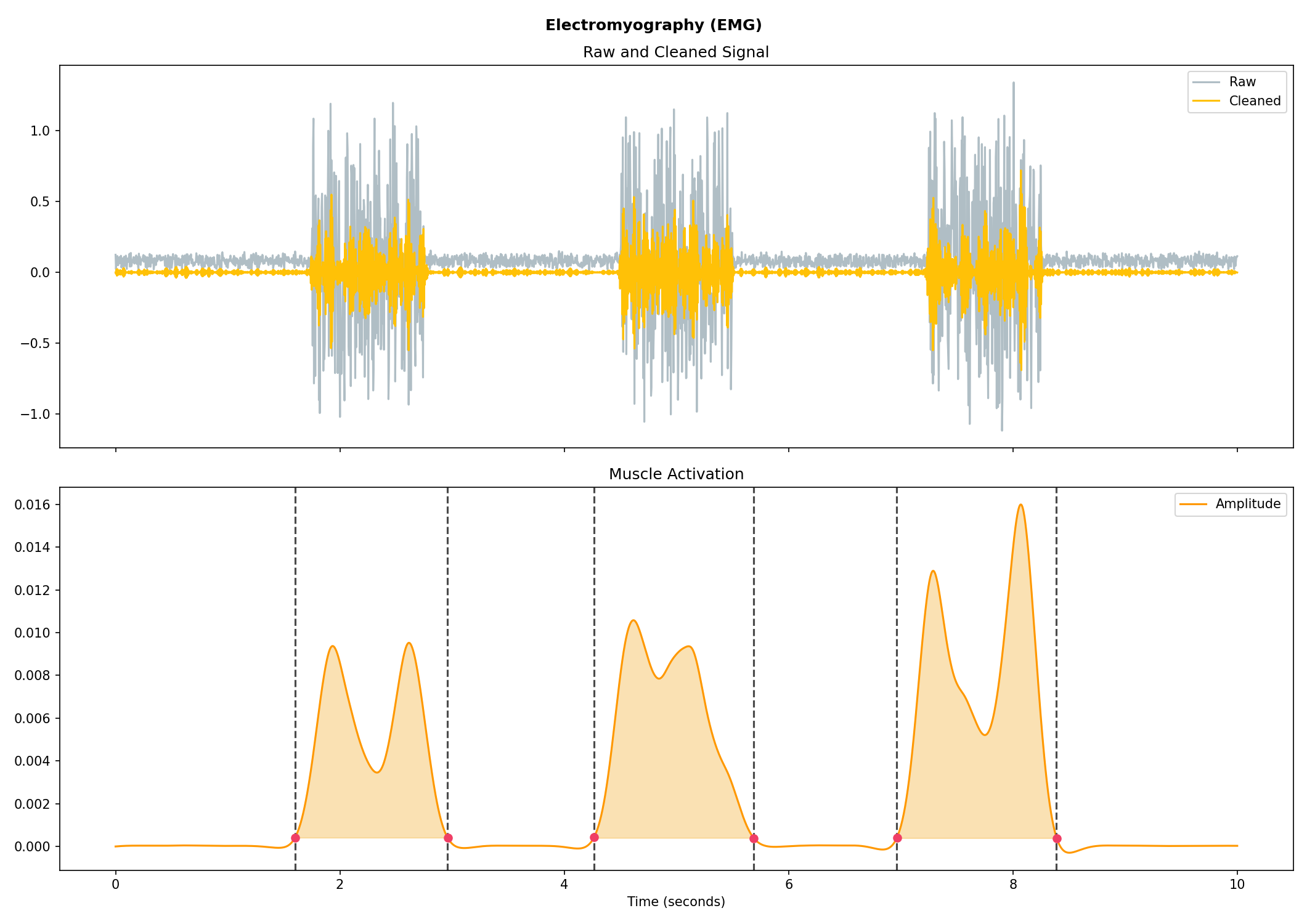
Photoplethysmography (PPG/BVP)
# Generate 15 seconds of PPG signal (recorded at 250 samples / second)
ppg = nk.ppg_simulate(duration=15, sampling_rate=250, heart_rate=70)
# Process it
signals, info = nk.ppg_process(ppg, sampling_rate=250)
# Visualize the processing
nk.ppg_plot(signals, sampling_rate=250)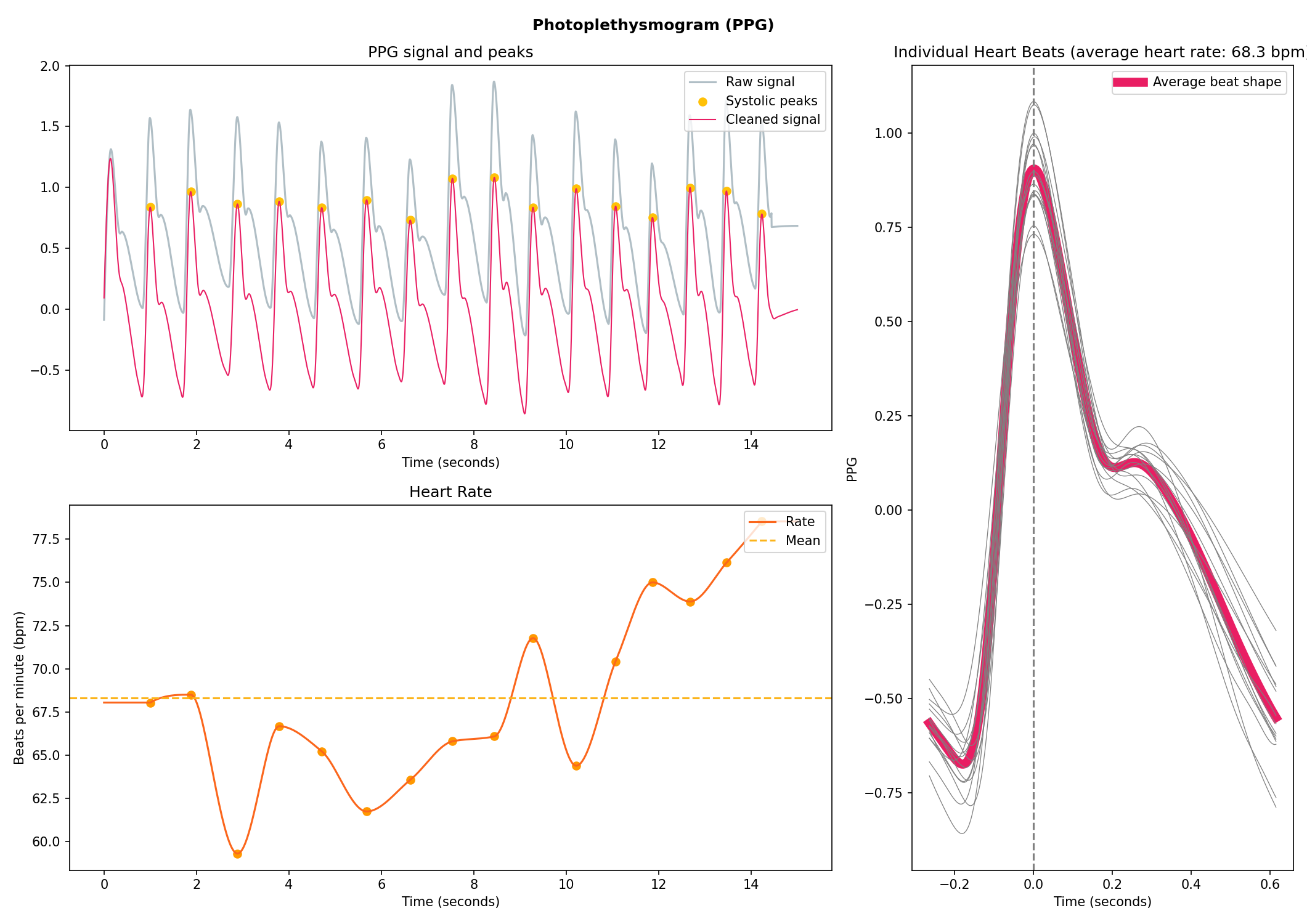
Electrooculography (EOG)
# Import EOG data
eog_signal = nk.data("eog_100hz")
# Process it
signals, info = nk.eog_process(eog_signal, sampling_rate=100)
# Plot
plot = nk.eog_plot(signals, info, sampling_rate=100)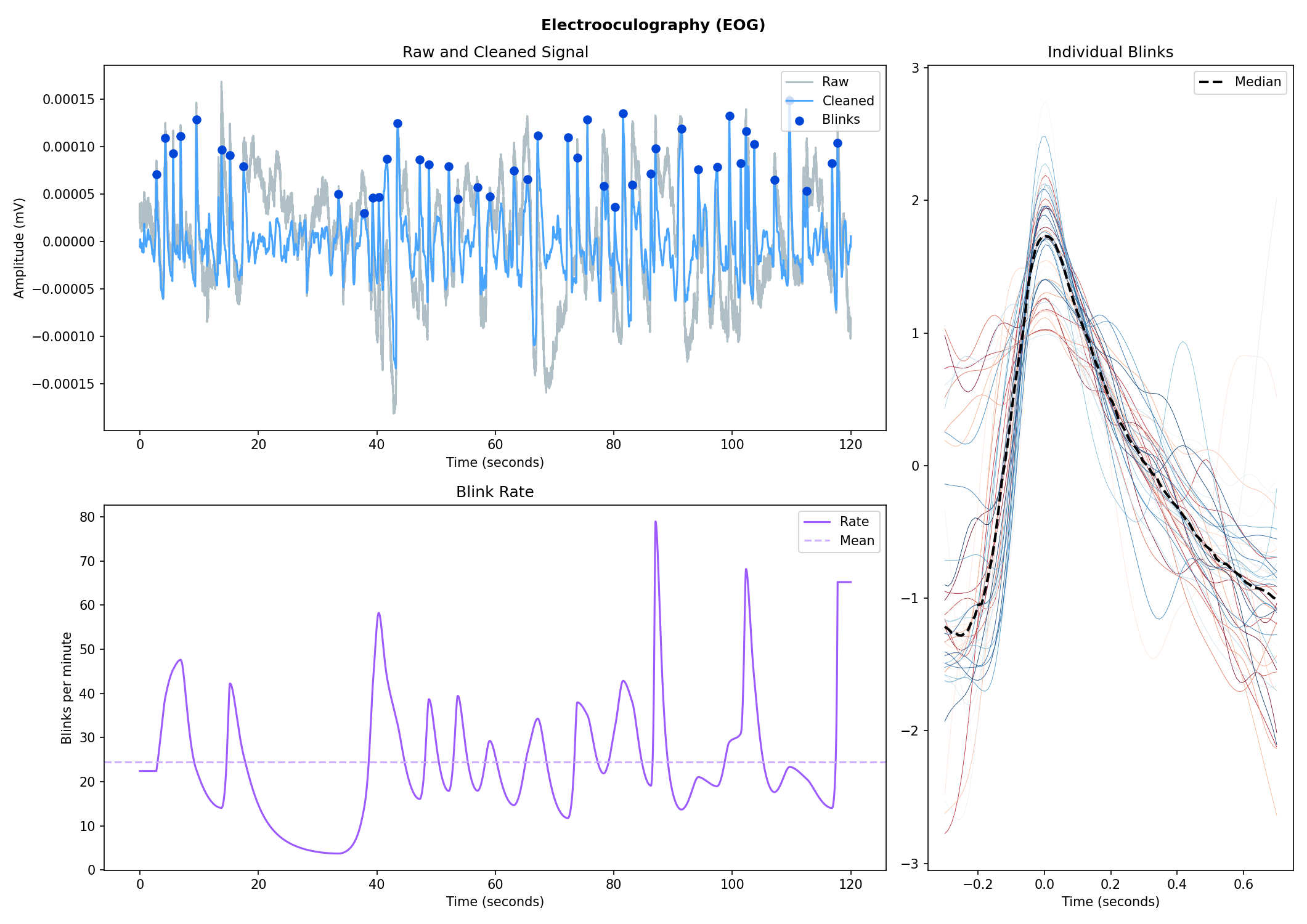
Electrogastrography (EGG)
Consider helping us develop it!
Physiological Data Analysis
The analysis of physiological data usually comes in two types, event-related or interval-related.
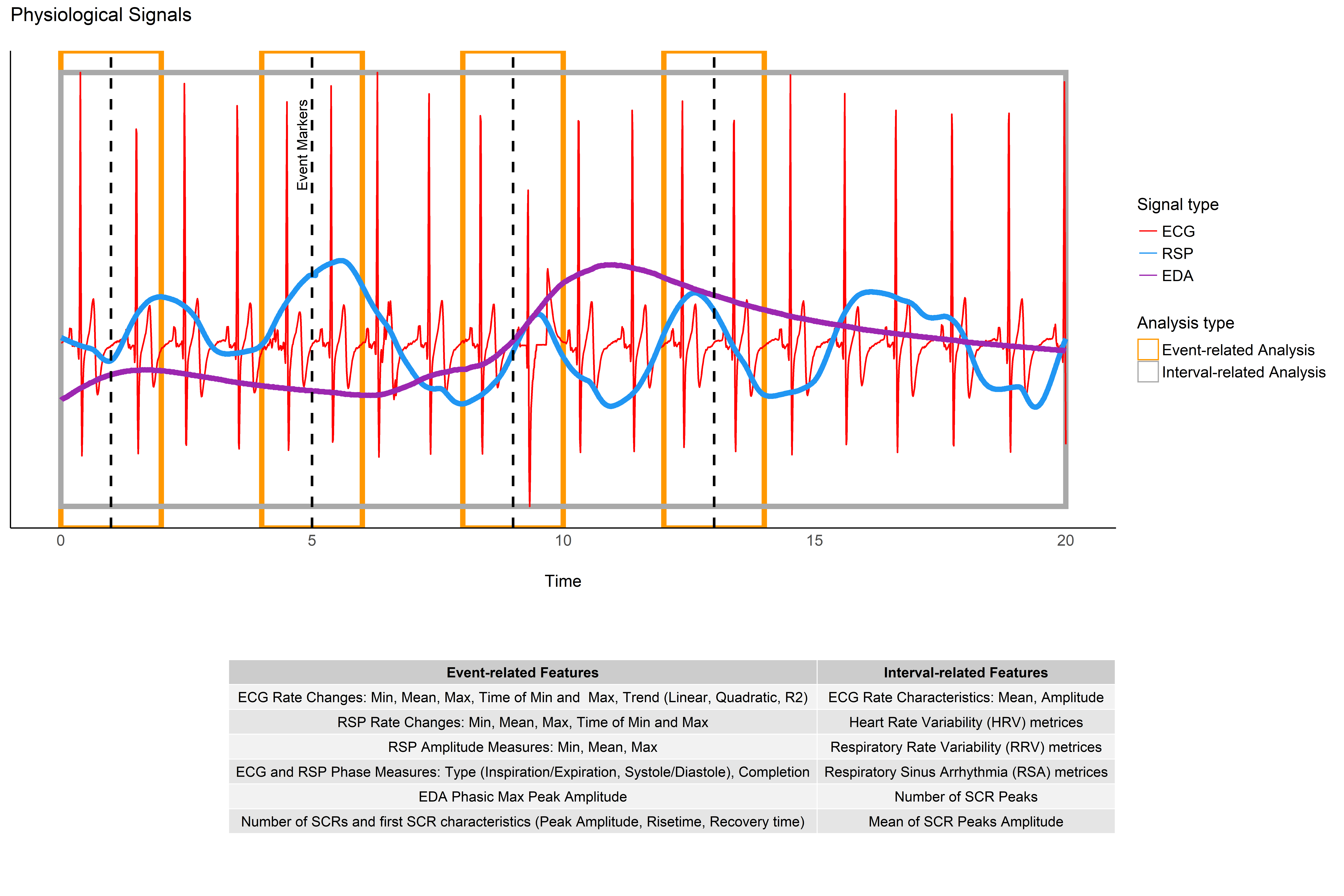
Heart Rate Variability (HRV)

If you are looking for:
a comprehensive review of the most up-to-date HRV indices
a discussion of their significance in psychological research and practices
a step-by-step guide for HRV analysis using NeuroKit2
the Heart Rate Variability in Psychology: A Review of HRV Indices and an Analysis Tutorial paper is a good place to start.
You can cite the paper as follows:
- Pham, T., Lau, Z. J., Chen, S. H. A., & Makowski, D. (2021).
Heart Rate Variability in Psychology: A Review of HRV Indices and an Analysis Tutorial.
Sensors, 21(12), 3998. https://doi:10.3390/s21123998
Full bibtex reference:
@article{Pham_2021,
author={Pham, Tam and Lau, Zen Juen and Chen, S. H. Annabel and Makowski, Dominique},
title={Heart Rate Variability in Psychology: A Review of HRV Indices and an Analysis Tutorial},
volume={21},
ISSN={1424-8220},
url={http://dx.doi.org/10.3390/s21123998},
DOI={10.3390/s21123998},
number={12},
journal={Sensors},
publisher={MDPI AG},
year={2021},
month={Jun},
pages={3998}
}Compute HRV indices
Time domain: RMSSD, MeanNN, SDNN, SDSD, CVNN etc.
Frequency domain: Spectral power density in various frequency bands (Ultra low/ULF, Very low/VLF, Low/LF, High/HF, Very high/VHF), Ratio of LF to HF power, Normalized LF (LFn) and HF (HFn), Log transformed HF (LnHF).
Nonlinear domain: Spread of RR intervals (SD1, SD2, ratio between SD2 to SD1), Cardiac Sympathetic Index (CSI), Cardial Vagal Index (CVI), Modified CSI, Sample Entropy (SampEn).
# Download data
data = nk.data("bio_resting_8min_100hz")
# Find peaks
peaks, info = nk.ecg_peaks(data["ECG"], sampling_rate=100)
# Compute HRV indices
nk.hrv(peaks, sampling_rate=100, show=True)
>>> HRV_RMSSD HRV_MeanNN HRV_SDNN ... HRV_CVI HRV_CSI_Modified HRV_SampEn
>>> 0 69.697983 696.395349 62.135891 ... 4.829101 592.095372 1.259931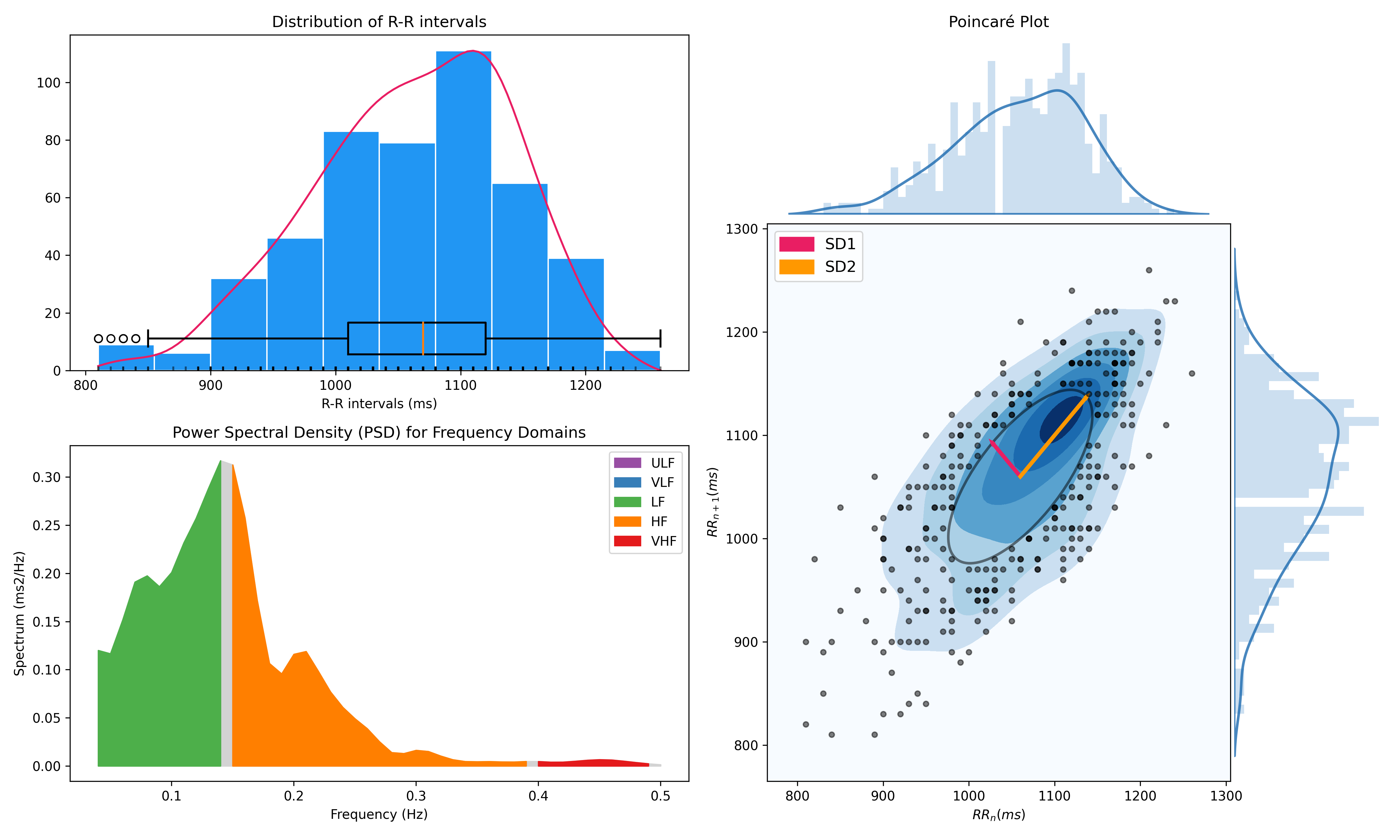
Miscellaneous
ECG Delineation
Delineate the QRS complex of an electrocardiac signal (ECG) including P-peaks, T-peaks, as well as their onsets and offsets.
# Download data
ecg_signal = nk.data(dataset="ecg_3000hz")['ECG']
# Extract R-peaks locations
_, rpeaks = nk.ecg_peaks(ecg_signal, sampling_rate=3000)
# Delineate
signal, waves = nk.ecg_delineate(ecg_signal, rpeaks, sampling_rate=3000, method="dwt", show=True, show_type='all')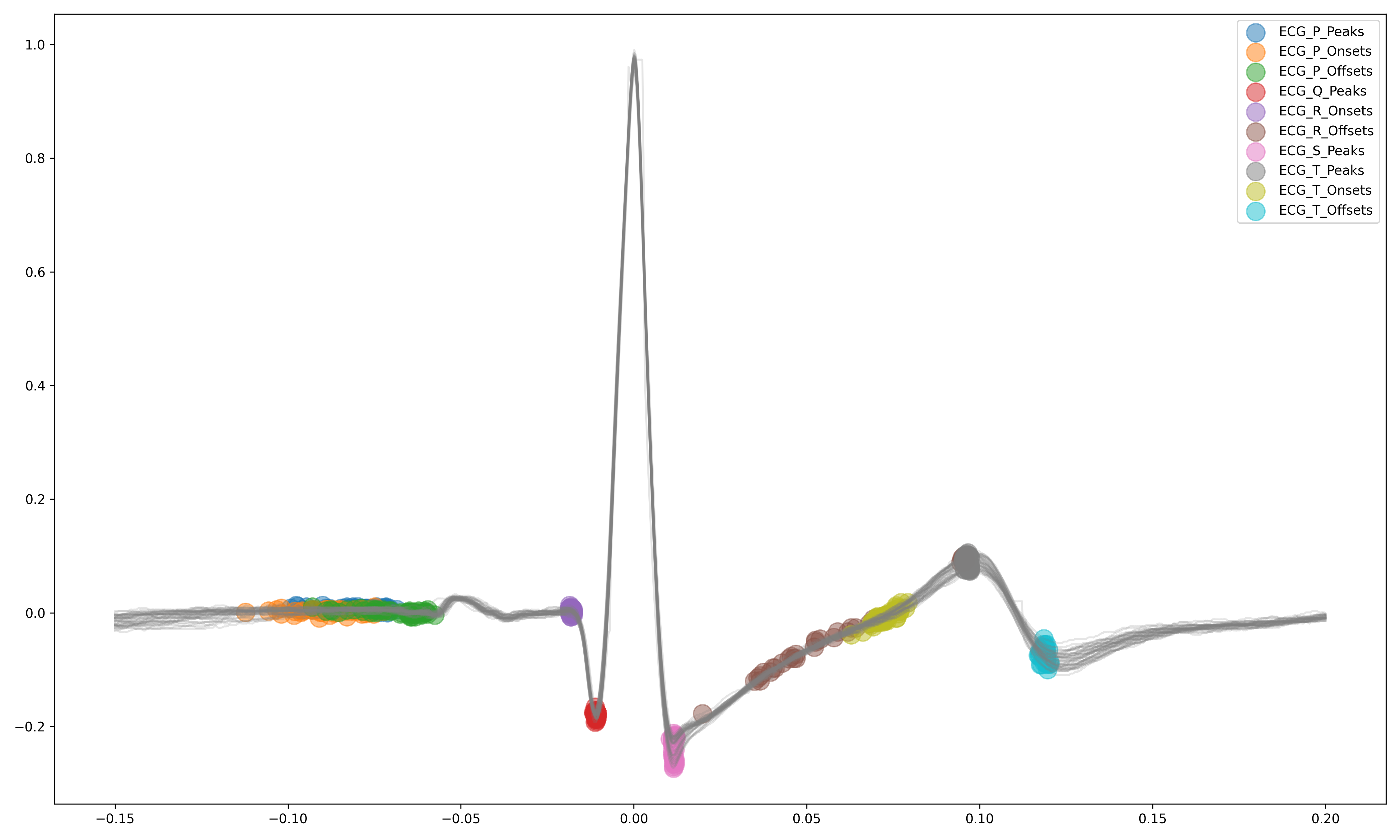
Signal Processing
Signal processing functionalities
Filtering: Using different methods.
Detrending: Remove the baseline drift or trend.
Distorting: Add noise and artifacts.
# Generate original signal
original = nk.signal_simulate(duration=6, frequency=1)
# Distort the signal (add noise, linear trend, artifacts etc.)
distorted = nk.signal_distort(original,
noise_amplitude=0.1,
noise_frequency=[5, 10, 20],
powerline_amplitude=0.05,
artifacts_amplitude=0.3,
artifacts_number=3,
linear_drift=0.5)
# Clean (filter and detrend)
cleaned = nk.signal_detrend(distorted)
cleaned = nk.signal_filter(cleaned, lowcut=0.5, highcut=1.5)
# Compare the 3 signals
plot = nk.signal_plot([original, distorted, cleaned])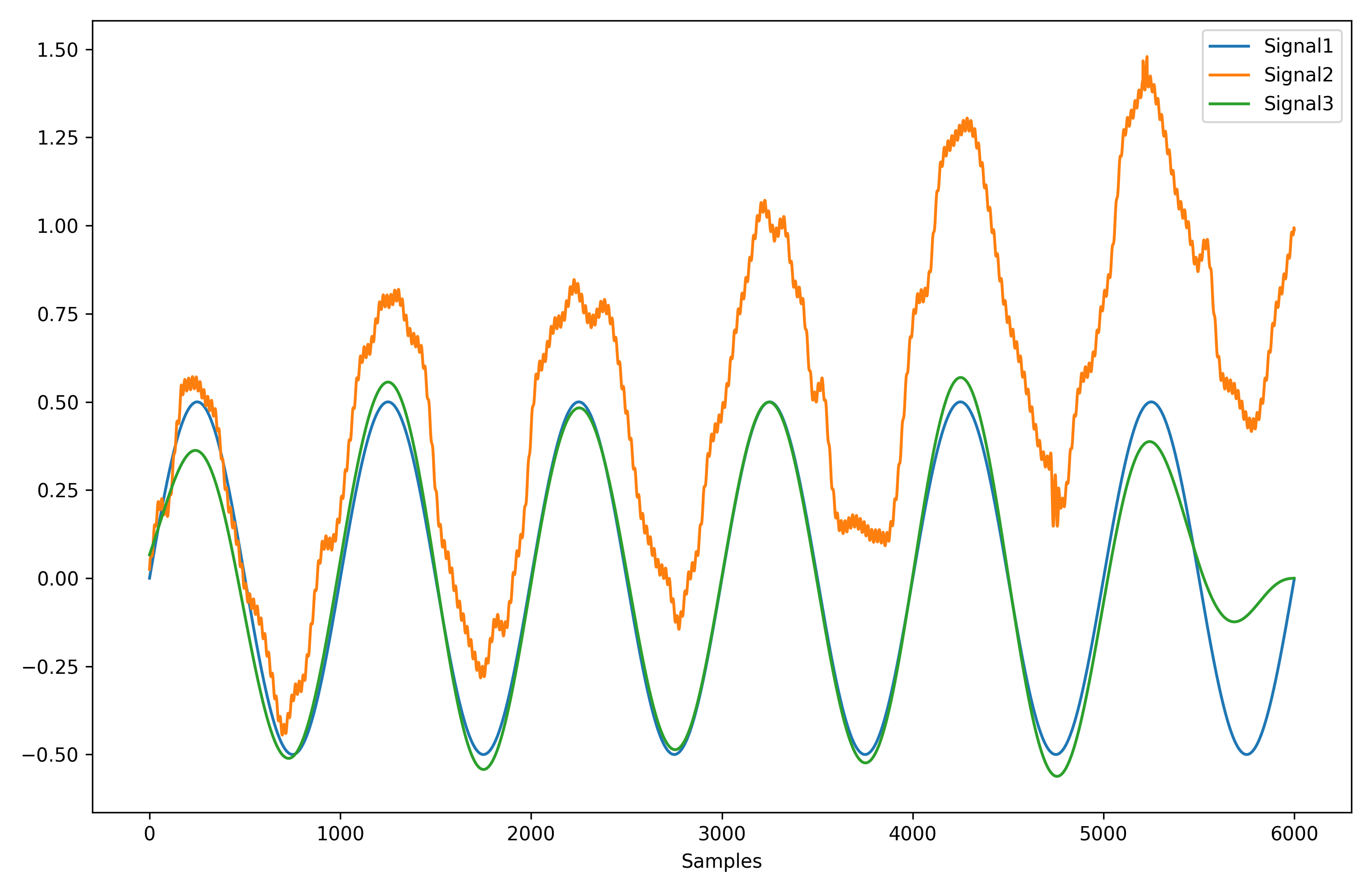
Complexity (Entropy, Fractal Dimensions, …)
Optimize complexity parameters (delay tau, dimension m, tolerance r)
# Generate signal
signal = nk.signal_simulate(frequency=[1, 3], noise=0.01, sampling_rate=100)
# Find optimal time delay, embedding dimension and r
parameters = nk.complexity_optimize(signal, show=True)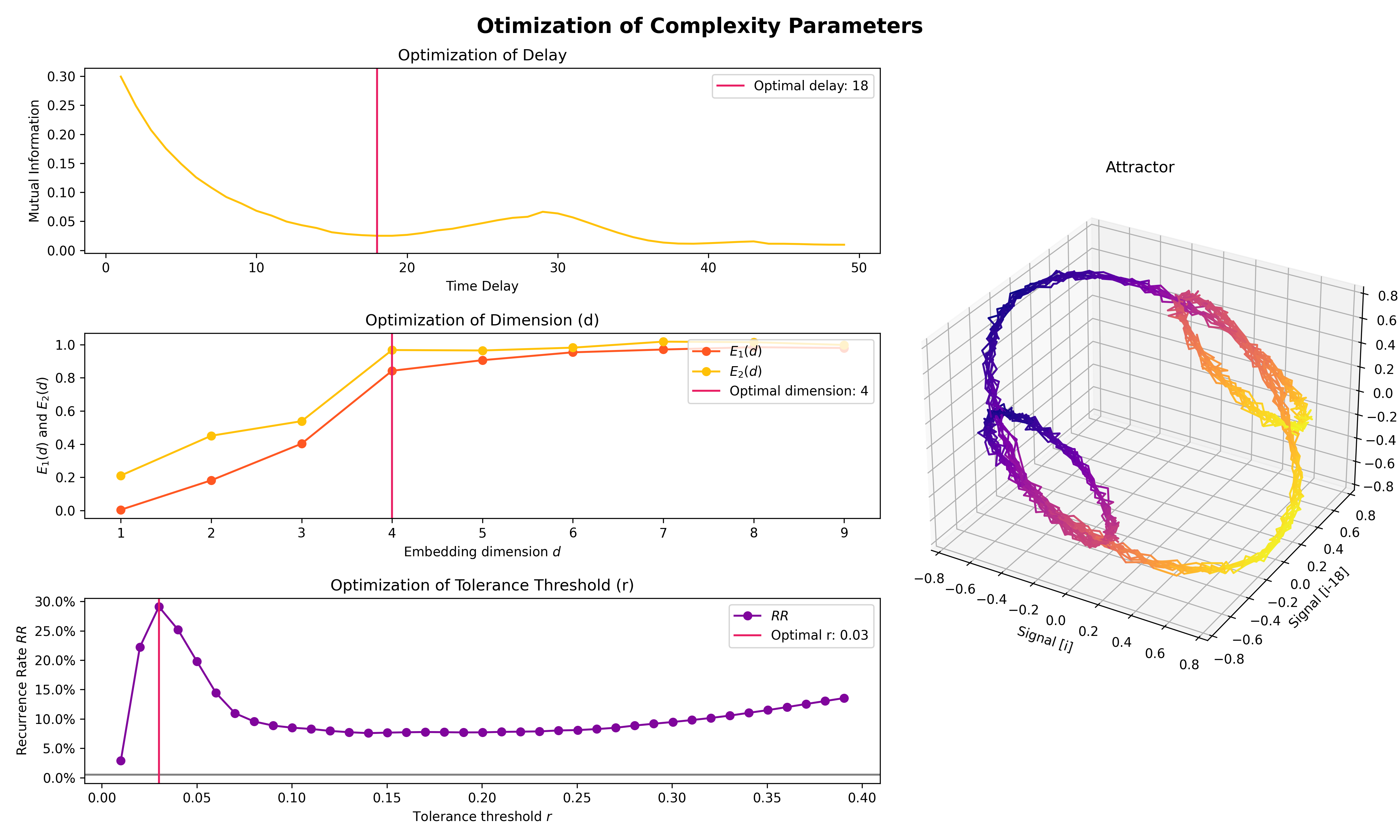
Compute complexity features
Entropy: Sample Entropy (SampEn), Approximate Entropy (ApEn), Fuzzy Entropy (FuzzEn), Multiscale Entropy (MSE), Shannon Entropy (ShEn)
Fractal dimensions: Correlation Dimension D2, …
Detrended Fluctuation Analysis
nk.entropy_sample(signal)
nk.entropy_approximate(signal)Signal Decomposition
# Create complex signal
signal = nk.signal_simulate(duration=10, frequency=1) # High freq
signal += 3 * nk.signal_simulate(duration=10, frequency=3) # Higher freq
signal += 3 * np.linspace(0, 2, len(signal)) # Add baseline and linear trend
signal += 2 * nk.signal_simulate(duration=10, frequency=0.1, noise=0) # Non-linear trend
signal += np.random.normal(0, 0.02, len(signal)) # Add noise
# Decompose signal using Empirical Mode Decomposition (EMD)
components = nk.signal_decompose(signal, method='emd')
nk.signal_plot(components) # Visualize components
# Recompose merging correlated components
recomposed = nk.signal_recompose(components, threshold=0.99)
nk.signal_plot(recomposed) # Visualize components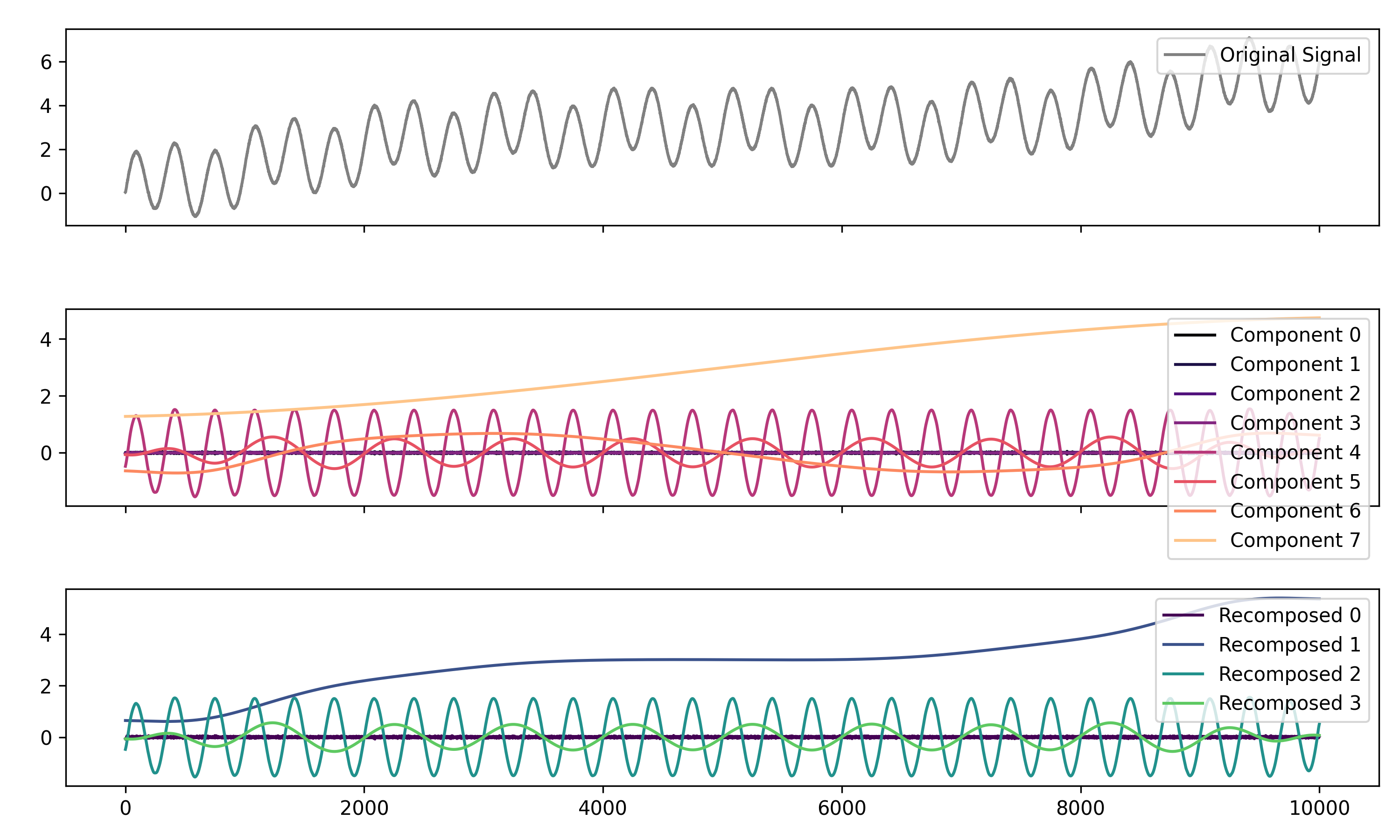
Signal Power Spectrum Density (PSD)
# Generate complex signal
signal = nk.signal_simulate(duration=20, frequency=[0.5, 5, 10, 15], amplitude=[2, 1.5, 0.5, 0.3], noise=0.025)
# Get the PSD using different methods
welch = nk.signal_psd(signal, method="welch", min_frequency=1, max_frequency=20, show=True)
multitaper = nk.signal_psd(signal, method="multitapers", max_frequency=20, show=True)
lomb = nk.signal_psd(signal, method="lomb", min_frequency=1, max_frequency=20, show=True)
burg = nk.signal_psd(signal, method="burg", min_frequency=1, max_frequency=20, order=10, show=True)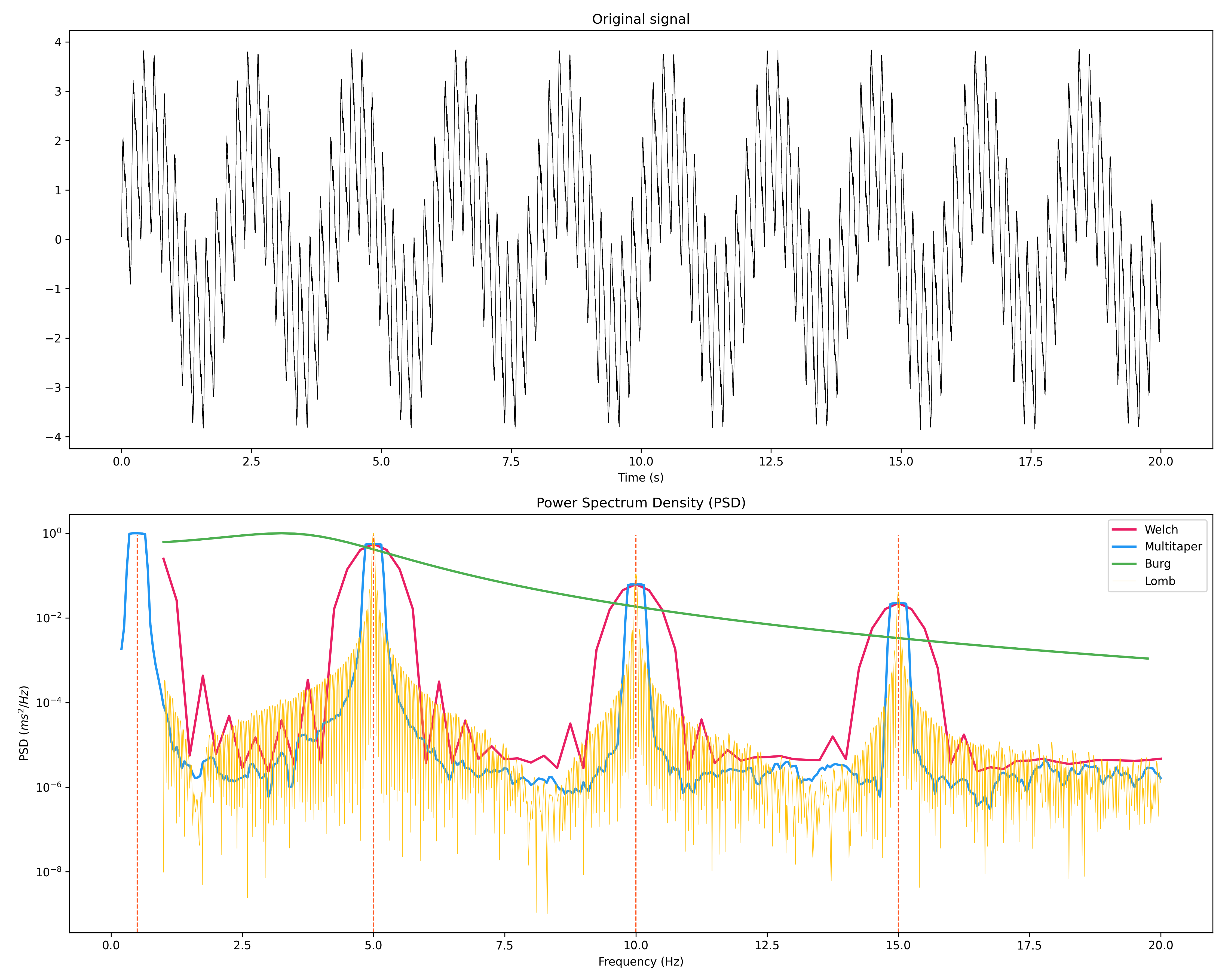
Statistics
Highest Density Interval (HDI)
x = np.random.normal(loc=0, scale=1, size=100000)
ci_min, ci_max = nk.hdi(x, ci=0.95, show=True)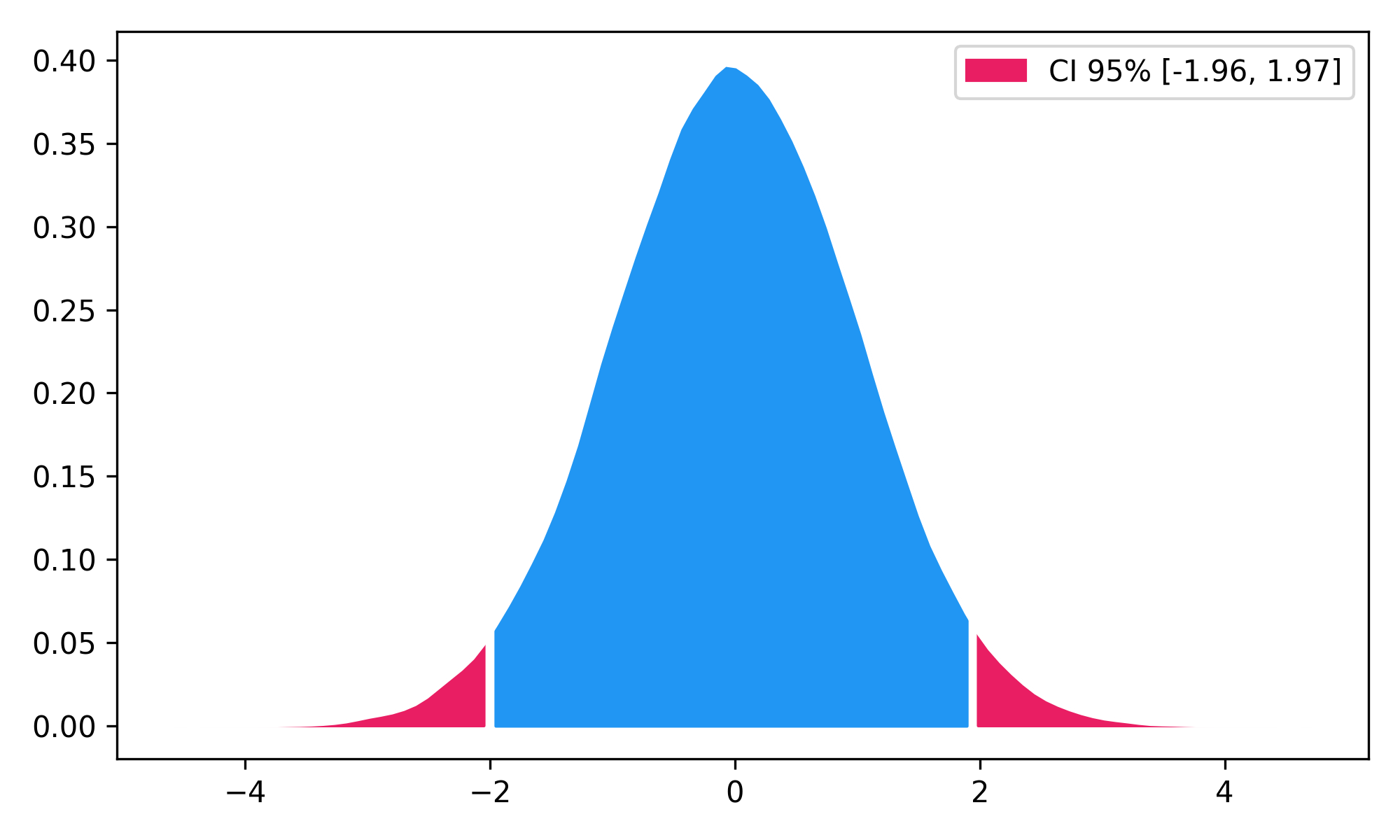
Popularity



NeuroKit2 is one of the most welcoming package for new contributors and users, as well as the fastest growing package. So stop hesitating and hop onboard 🤗
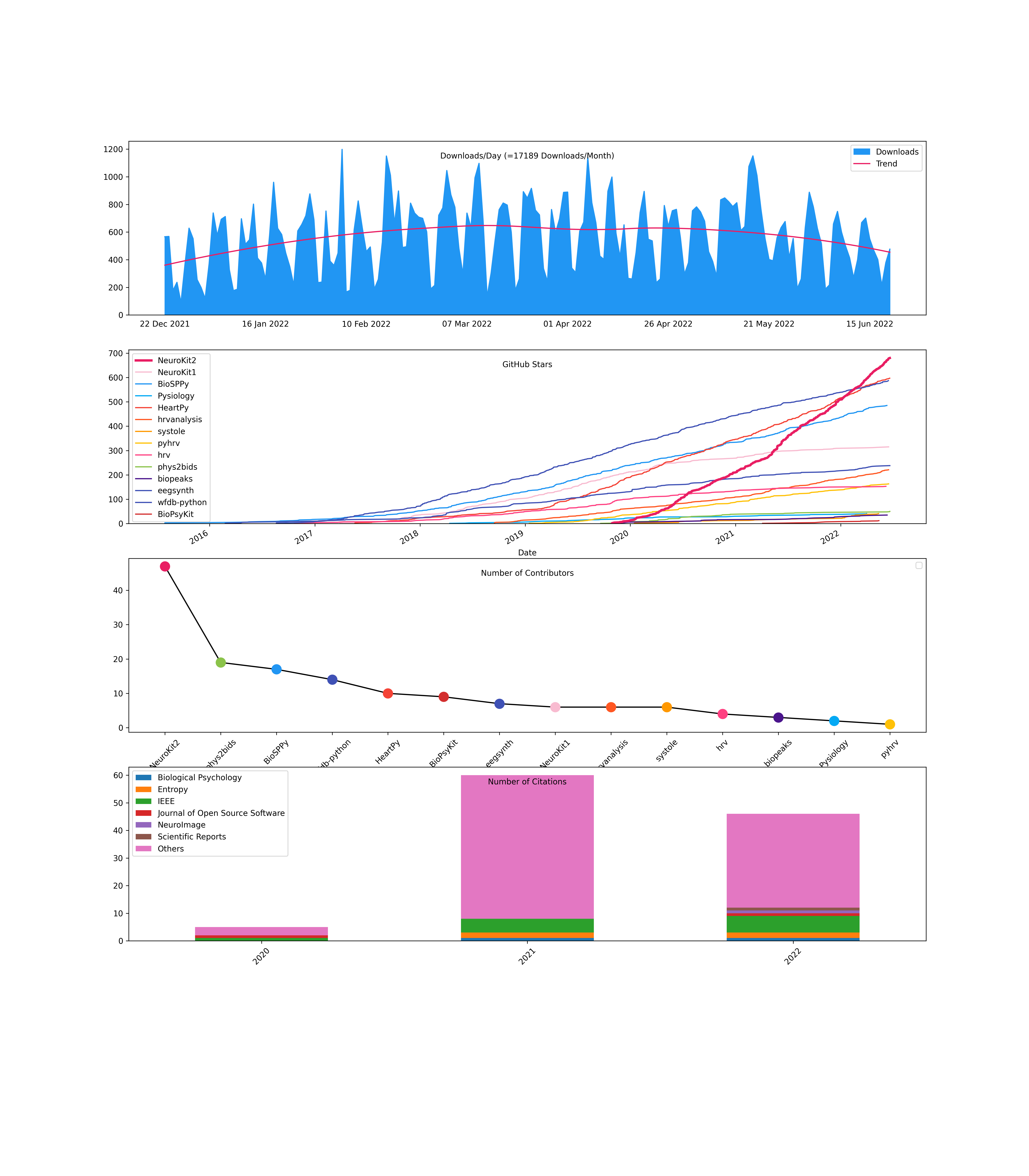
Notes
The authors do not provide any warranty. If this software causes your keyboard to blow up, your brain to liquefy, your toilet to clog or a zombie plague to break loose, the authors CANNOT IN ANY WAY be held responsible.
News
0.1.3
Breaking Changes
None
New Features
Add internal function for detecting missing data points and forward filling missing values in nk.*_clean() functions
Add computation of standard deviation in eventrelated() functions for ECG_Rate_SD, EMG_Amplitude_SD, EOG_Rate_SD, PPG_Rate_SD, RSP_Rate_SD, RSP_Amplitude_SD
Add labelling for interval related features if a dictionary of dataframes is passed
Retrun Q peaks and S Peaks information for wavelet-based methods in nk.ecg_delineate()
Fixes
Fix epochs columns with dtype: object generated by nk.epochs_create()
Bug fix ecg_findpeaks_rodrigues for array out of bounds bug
0.1.2
New Features
Additional features for nk.rsp_intervalrelated(): average inspiratory and expiratory durations, inspiratory-to-expiratory (I/E) time ratio
Add multiscale entropy measures (MSE, CMSE, RCMSE) and fractal methods (Detrended Fluctuation Analysis, Correlation Dimension) into nk.hrv_nonlinear()
Allow for data resampling in nk.read_bitalino()
Add bio_resting_8min_200hz into database for reading with nk.data()
Reading of url links in nk.data()
Allow for nk.hrv() to compute RSA indices if respiratory data is present
All hrv functions to automatically detect correct sampling rate if tuple or dict is passed as input
Add support for PPG analysis: nk.ppg_eventrelated(), nk.ppg_intervalrelated(), nk.ppg_analyze()
Add Zhao et al. (2018) method for nk.ecg_quality()
Add tests for epochs module
- Add sub-epoch option for ECG and RSP event-related analysis:
users can create a smaller sub-epoch within the event-related epoch
the rate-related features of ECG and RSP signals are calculated over the sub-epoch
the remaining features are calculated over the original epoch, not the sub-epoch
Fixes
Fix propagation of values in nk.signal_formatpeaks() for formatting SCR column outputs generated by eda_peaks()
Fix docstrings of nk.rsp_phase(), from “RSP_Inspiration” to “RSP_Phase”
Update signal_filter() method for rsp_clean(): to use sos form, instead of ba form of butterworth (similar to eda_clean())
0.1.1
New Features
Use duration from nk.events_find() as epochs_end in nk.epochs_create()
Allow customized subsets of epoch lengths in nk.bio_analyze() with window_lengths argument
Add nk.find_outliers() to identify outliers (abnormal values)
Add utility function - nk.check_type() to return appropriate boolean values of input (integer, list, ndarray, pandas dataframe or pandas series)
(experimental) Add error bars in the summary plot method to illustrate standard error of each bin
Fixes
Fix type of value in nk.signal_formatpeaks() to ensure slice assignment is done on the same type
0.0.1 (2019-10-29)
First release on PyPI.
Project details
Release history Release notifications | RSS feed
Download files
Download the file for your platform. If you're not sure which to choose, learn more about installing packages.
Source Distribution
Built Distribution
Hashes for neurokit2-0.1.3-py2.py3-none-any.whl
| Algorithm | Hash digest | |
|---|---|---|
| SHA256 | 2f4a40fa5f8ee537bcd8d5464f13f96c98c266f562a8b07b4b5ecca34a26ca3d |
|
| MD5 | 0498913b2cae420997691523e7564889 |
|
| BLAKE2b-256 | cdf2fcb84645cf89c567e230c1ffa2dc1edb44709fbd6a82bd4fd1329d3a1fd4 |











